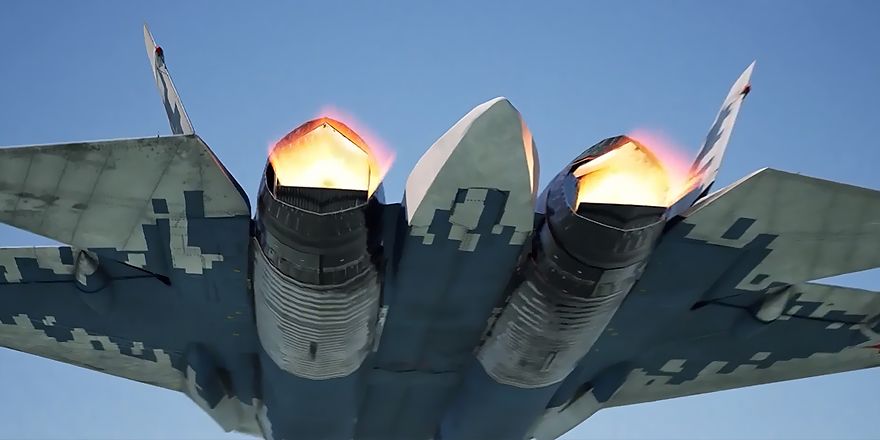- While Western fifth-generation fighters like the F-35 emphasize data fusion and multinational interoperability, the Su-57M distinguishes itself through airframe agility and extended-range radar capabilities.

- The AI-supported avionics simplify cockpit workload and reduce decision-making time, providing the Russian pilot with a tactical edge in complex engagements.
- Although it may not yet match the F-35’s sensor fusion or fleet size, the Su-57M reflects Russia’s tailored priorities: speed, self-reliance, and standoff lethality.
ALERT: Russia Enhances Su-57M1 Fighter Jet with Artificial Intelligence and Aerodynamic Upgrades.
On May 15, 2025, Russia’s United Aircraft Corporation (UAC), via the Sukhoi Design Bureau, unveiled key features of the upgraded Su-57M fifth-generation stealth fighter. Marking a major step in Russia’s push for a modern multi-role air superiority platform, test pilot Sergei Bogdan highlighted its advanced technologies and aerodynamic upgrades. With AI integration, enhanced stealth, and long-range radar, the Su-57M is set to bolster Russia’s air deterrence and influence in contested skies.
Follow Army Recognition on Google News at this link

The Su-57M is the most advanced evolution of Russia’s fifth-generation fighter project, designed for stealth, speed, and multi-role capability. The aircraft features a wider airframe that improves aerodynamic lift and stability at supersonic speeds, enabling it to cruise at such velocities without afterburners, a key benchmark of true fifth-generation capability.
According to Army Recognition and statements from test pilot Sergei Bogdan, the onboard systems are now AI-assisted, allowing for rapid system initialization with a single-button press. This automation streamlines pre-flight checks and mission readiness.- The Su-57M incorporates upgraded engines, reportedly the Saturn AL-51 offering improved thrust and fuel efficiency.
- Its flat fuselage and internal weapon bays enhance stealth by reducing radar cross-section, while a new radar system significantly increases detection range and situational awareness.
- Ammunition is fully enclosed within the glider structure, supporting its low observability profile in combat environments.
- The Su-57M, however, represents a generational upgrade rather than a simple refinement. It includes reworked avionics, improved thrust-vectoring engines, and battlefield connectivity features.
- Lessons from limited operational deployments and testing phases have informed iterative enhancements that now define the Su-57M as a more mature and capable platform.
- Sukhoi’s integration of automated system checks and pilot support functions through AI reflects a broader shift toward autonomy and human-machine teaming in Russian aerospace doctrine.
Strategically, the Su-57M strengthens Russia’s capacity to project airpower across contested regions such as Eastern Europe, the Arctic, and Central Asia.
With growing NATO forward deployments and increased U.S. presence in Eastern Europe, Moscow views the Su-57M as a key component of its anti-access/area-denial (A2/AD) doctrine. The aircraft’s stealth and extended-range radar can be force multipliers in high-threat environments, especially when deployed in coordinated formations with UAVs and support aircraft. Militarily, the aircraft addresses Russia’s long-standing deficit in stealth capability, while geopolitically it serves as a symbol of technological resilience despite international sanctions. Its development also signals a clear message to potential export clients: Russia is not only capable of fielding a fifth-generation fighter but of continually improving it under pressure.
The Su-57M is not merely an update, it is a key milestone in Russia’s strategy to field an autonomous, AI-assisted, fifth-generation fighter capable of competing with the most advanced platforms in the world. With its supersonic cruise, stealth-enhanced design, AI-enabled systems, and powerful radar suite, the Su-57M reflects Russia’s prioritization of strategic air defense, indigenous innovation, and reduced technological dependency. As global airpower competition intensifies, the Su-57M stands as both a tactical tool and a political signal, asserting Russia’s intent to remain a major force in next-generation aerial warfare.
Rusya SU-57M1 Savaş Uçağını Yapay Zeka Ve Aerodinamik Yükseltmelerle Geliştirdi!

United Aircraft Corporation (UAC), Yükseltilmiş SU-57M 5. nesil hayalet avcı uçağının yapay zeka entegrasyonu, gelişmiş gizlilik ve aerodinamik özellikler ile geliştirildiğini açıkladı…
RELATED
armyrecognition.com
9 hours ago






No comments:
Post a Comment